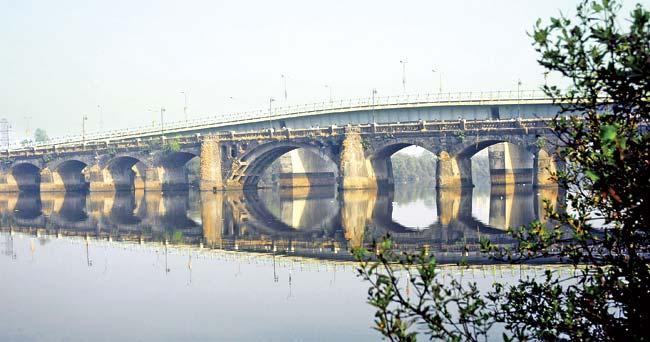Close to nature but some trepidation about the future, that sums up the sentiment of the residents here

One of the most lucrative spaces on the real estate map, Thane on the outskirts of Mumbai is a green haven that these people call home. Trinette Carvalho, a lecturer says, “Living in Thane gives me a sense of living in the city and having my own space to unwind.
ADVERTISEMENT
 Thane’s iconic Upvan Lake
Thane’s iconic Upvan Lake
However, on the flipside, there are several roads here that are in need of repairs and the Thane Municipal Commission (TMC) isn’t doing much. Also, we get irregular water supply which is a problem.”
Nature and recreation
She adds, “Thane is still well connected to green spaces; the Yeoor Hills are like nature’s centaurs for the city. They make living in Thane beautiful. In the last decade, many new malls have come up and also gardens have developed.

A view of Kalwa Bridge that connects Thane with Navi Mumbai
These allow for more relaxation and recreation.” “In the next few years, I see Thane becoming a lot like Mumbai when it comes to growth and international popularity,” says Carvalho.
The Yeoor Hills are a favourite morning walking spot for media professional, Srabana Lahiri who says, “The view of the hills and Sanjay Gandhi National Park (SGNP) makes picnics and nature trails more possible for me, here.

I am also closer to Lonavala and Nashik and so even a weekend outing is more convenient. The airport is closer and getting to town is also easier.”
“The new malls, hospitals and latest showrooms are all here in Thane. The trees all around make Thane have a fragrance of its own. I just wish that there were more employment options for people here in Thane. I commute to Bandra every day and find it closer than Borivali, Kandivali and Malad in the Western suburbs,” she adds.
Civic issues
Lahiri says, “Though Thane in my view is a microcosm of Mumbai, the TMC has a lot that they can work on. I love the greenery and the drop in temperatures every time I go home to Thane, but the garbage problems and bad roads in certain places need to be addressed.
Also, a number of trees have been wantonly cut which needs to stop, we need greenery in Thane as that is one of the best things about living here.” Agreeing with her, Dayanand Nene who is part of the Saket Advance Locality Management (ALM) and runs Alert Citizens of Thane, a Non-government Organisation (NGO) says, “Waste management in the city still needs to be addressed.
There is a hawker menace which exists and needs to be taken care of. Also, the rickshaws and buses give people a lot of woe when they have to travel. The lighting, footpaths and gutters need more attention.”
Shannen Castelino, an archival professional says, “Public transportation in the city is a major problem, especially after standing for an hour at the bus stop. The buses break down in the middle of the road far too often.
Frequency of buses is another issue that everyone has to face, which is why people choose to travel by share an auto which also leads you to an endless queue adding to chaos, confusion and traffic among drivers and pedestrians.”
Changes and development
Talking about how Thane has developed over the years, she says, “New residential projects and redevelopment plans in the city have come up. This has seen an increase in population in the city, which causes a pressure on the public transport within the city.”
Nene, who has lived in Thane for more than 20 years, says, “Thane was a small, sleepy town but over the years, there has been a robust spike in development. The face of Thane has changed as property rates have gone up.
There are more buildings now, but there has been planned development here, so the balance between nature and urbanisation is decent. The Municipal building and St John’s Church with the lakes nearby is what makes Thane iconic and in a sense shows the balance of iconic buildings and nature at its best.”
“Thane has great connectivity to Mumbai via the Eastern Expressway and the Central Railway. The property rates are on the rise, so now owning a house in Thane has become difficult. To be so close to Mumbai and be developed as a hub that balances greenery and development works for Thane on the real estate front,” says Lahiri.
Future talk
Castelino doesn’t see a lot of positives for Thane in the future. She says, “I see Thane suffering with a lot of pressure on resources due to increase in population. The city plans to turn concrete and move vertical with its 30- and 40-storey buildings. I love the hills and the trees, but the increase in concrete all around makes me fear for the future.”
In Nene’s view, Thane has the best ahead with a Mumbai Metro extension planned to connect Thane. He says, “I see Thane becoming a smart city, like Prime Minister Narendra Modi is propagating.
Better intercity connections via East-West links, illegal buildings being stopped, ALMs working to solve local issues will make Thane commercially better than Mumbai in the next 10 to 20 years.”
This is the first part of our weekly series on different areas in Mumbai, through the lens of the locals
 Subscribe today by clicking the link and stay updated with the latest news!" Click here!
Subscribe today by clicking the link and stay updated with the latest news!" Click here!






